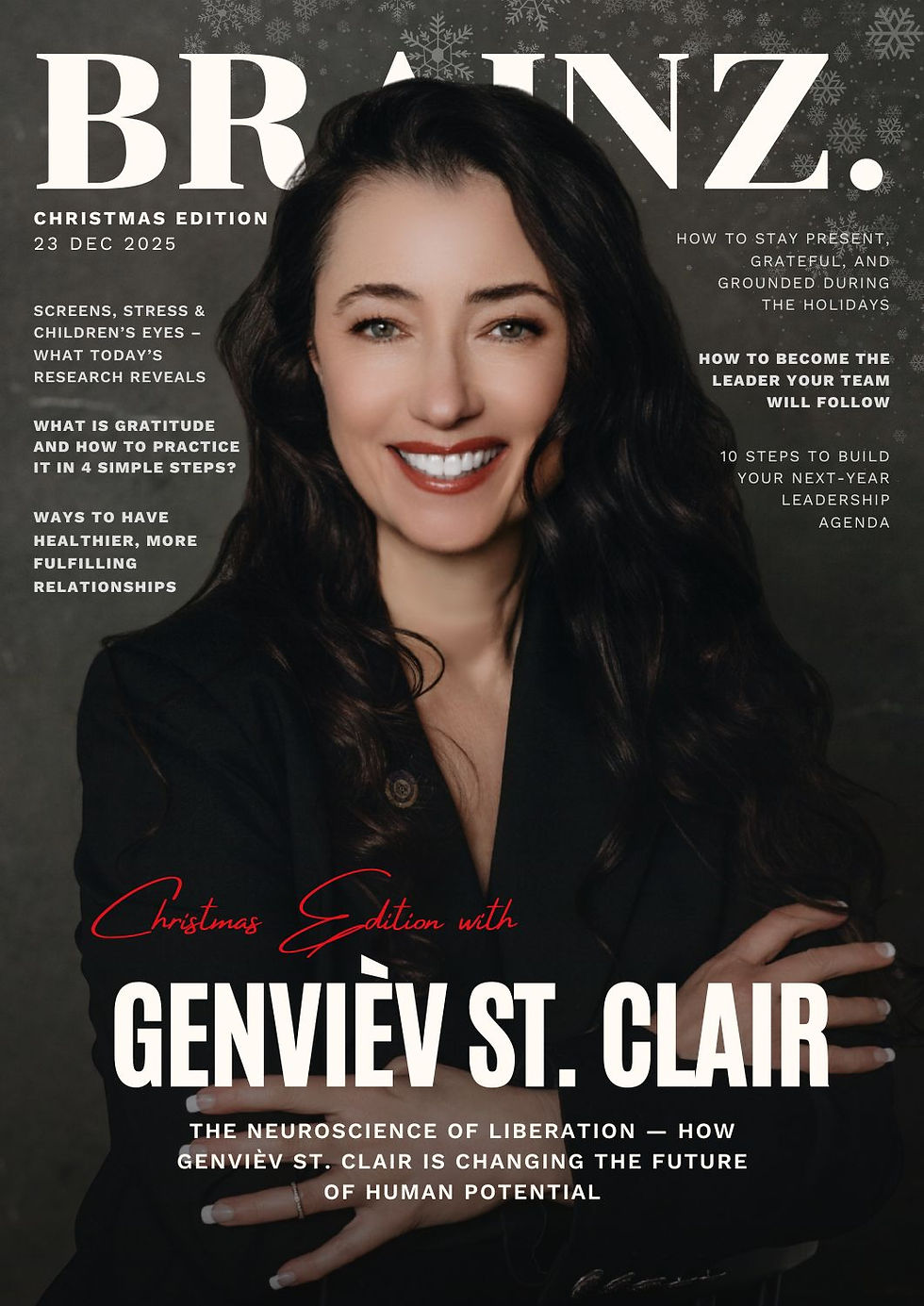Beyond Integration and Why "Parts Separation" May Be the Key to Peak Mindset Transformation
- Brainz Magazine

- May 4
- 5 min read
Written by Susan L Williams, Clinical Hypnotherapist
Dr. Susan L. Williams, also known as Dr. Sue, is a pioneering clinical hypnotherapist with a unique expertise spanning athletes, sports teams, executives, and entrepreneurs. In her thriving practice, now in its fourth year, Dr. Sue employs innovative hypnotherapy techniques to help athletes overcome barriers such as negative mindsets, limiting beliefs, and the psychological impact of injuries and setbacks.

When it comes to building a powerful mindset for elite performance, most people hear about integrating their conflicting inner voices into a harmonious whole. But what if, instead of merging everything together, the real key to excellence is creating a separate, high-performing version of yourself? In Peak Mindset Coaching, parts separation is not only possible; it is the strategy that accelerates success without sacrificing authenticity.

When it comes to personal transformation, especially in hypnotherapy and mindset coaching, we often hear about the concept of parts integration, the process of blending conflicting aspects of ourselves into a unified whole. While integration is a powerful therapeutic tool, there is another approach that can be even more effective for athletes, entrepreneurs, and high performers seeking targeted, rapid change: parts separation.
In my Peak Mindset Coaching practice, parts separation is a core methodology. Instead of merging conflicting parts into one, we create a distinct new version of the self, the "champion persona," while allowing the original self to remain intact. This method gives clients permission to evolve without losing the essence of who they are.
In this article, we explore why parts separation is such a powerful tool for peak performance, how it differs from traditional integration, and how it allows individuals to step into excellence while maintaining authenticity.
What is parts integration?
In traditional hypnotherapy and psychological practices, parts integration is used when individuals experience internal conflict, for instance, one part wants to succeed, while another part sabotages success out of fear. Techniques like Neuro-Linguistic Programming (NLP) use parts integration to harmonize these opposing drives, creating inner peace and alignment (source: NLP Comprehensive).
While effective for resolving emotional or behavioral conflicts, parts integration can sometimes dilute distinct identities. For high performers who need to operate with a razor-sharp mindset in one area of life, without necessarily changing everything else, an alternative is needed.
The concept of parts separation
Parts separation is based on the idea that we can consciously create a new version of ourselves, designed specifically for success, leadership, or high achievement, while keeping our "everyday self" intact.
In Peak Mindset Coaching, clients are guided to develop a "champion self," built from intentional traits: resilience, confidence, focus, leadership, and discipline. This champion self is distinct, accessible on demand, and trained to perform at an elite level. Crucially, the original persona remains untouched; it is simply joined by a new, specialized version.
Instead of asking the subconscious mind to merge conflicting parts into compromise, we create separation with purpose. Clients feel empowered because they do not have to "fix" themselves; they simply step into a new identity when needed.
This process has parallels in psychological theories of self-concept and multiple selves, where people naturally hold different versions of themselves depending on the context, such as parent, athlete, entrepreneur, or friend (source: Verywell Mind).
Why parts separation works for high performers
For athletes, executives, and creatives, performance often demands extraordinary levels of focus and confidence that are not required in daily life. Asking someone to permanently integrate the "ultra-disciplined, competition-level" version of themselves into every aspect of their life can create burnout or a loss of authenticity.
Parts separation offers several advantages:
1. Immediate activation
Once a client trains their "champion self," it can be activated at will through triggers like a physical gesture, breathing technique, or visualization anchor. This immediate activation ensures the mindset shift happens exactly when needed (source: Psychology Today).
2. Preservation of authenticity
Clients do not feel they have to "change who they are" to succeed. Their everyday self, the one that loves downtime, family, and hobbies, remains genuine. The champion self simply becomes a tool they can use when performance matters most.
This is particularly important in contexts like martial arts. A martial artist must embody laser focus, rapid decision-making, and controlled aggression during competition, where split-second attack and defense actions are critical. However, carrying that same heightened, combative state into everyday interactions would be not only exhausting but socially inappropriate. Through parts separation, athletes like martial artists can embody their peak competitive self during performance, and then effortlessly return to their calm, everyday persona afterward.
3. Minimized inner conflict
Because the original self is not being forced to give up old patterns permanently, there is less resistance. Clients embrace change more easily when they know it is selective and purposeful.
4. Faster results
With separation, there is no need for endless emotional processing. The focus is on building a powerful new mindset rather than endlessly reconciling the old one.
In my experience, clients undergoing parts separation often see dramatic improvements in confidence, resilience, and performance within just a few sessions.
How the parts separation process works
Here is a simplified outline of how we use parts separation in Peak Mindset Coaching:
Identity mapping: We define the traits, emotions, and behaviors of the desired "champion self."
Visualization and embodiment: Clients experience a deep visualization session where they meet and merge with their champion self temporarily, establishing energetic familiarity.
Trigger installation: A trigger, such as a gesture or mantra, is created to instantly access the champion persona.
Practice and reinforcement: Over several sessions, clients strengthen the neural pathways and emotional anchoring to make the activation automatic.
Boundary setting: Clients learn to intentionally "switch off" the champion self when not needed, allowing their original persona to remain balanced and authentic.
This is a very different approach from integration techniques that seek to heal internal conflicts. Parts separation is about optimizing performance for specific life arenas.
The future of mindset training: More than one self
As neuroscience and psychology evolve, there is growing recognition that context-specific identities are normal and even beneficial (source: Frontiers in Psychology). We are complex beings with a multitude of selves that serve different roles in our lives.
Parts separation honors that complexity. It acknowledges that excellence in one area does not require sacrificing balance in another. For those serious about reaching new heights, whether on the field, in the boardroom, or on the stage, creating a new self can be the ultimate strategic move.
Ready to meet your champion self?
Visit PeakMindset.Coach to learn more about Peak Mindset Coaching and how parts separation can help you unlock your full potential. Let’s create a version of you that is unstoppable when it matters most.
Follow me on Facebook, Instagram, LinkedIn, and visit my website for more info!
Susan L Williams, Clinical Hypnotherapist
Dr. Susan L. Williams, also known as Dr. Sue, is a pioneering clinical hypnotherapist with a unique expertise spanning athletes, sports teams, executives, and entrepreneurs. In her thriving practice, now in its fourth year, Dr. Sue employs innovative hypnotherapy techniques to help athletes overcome barriers such as negative mindsets, limiting beliefs, and the psychological impact of injuries and setbacks. She also empowers executives and entrepreneurs to overcome self-doubt and ingrained limitations, guiding them towards achieving a 'millionaire mindset'. Her approach shows that hypnosis caters to different audiences and the core methods are complementary and equally transformative.










.jpg)